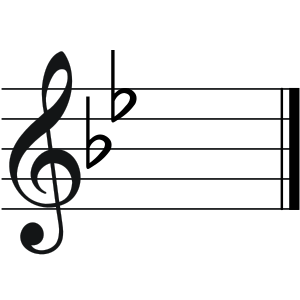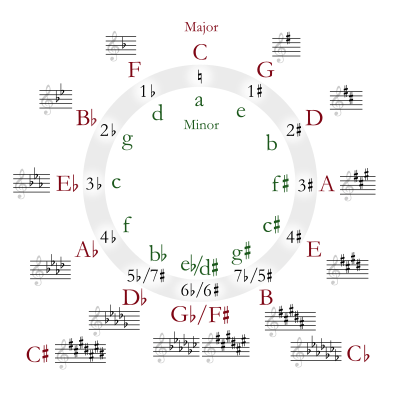Key signature facts for kids
In musical notation, a key signature is a set of sharp (♯), flat (♭), and rarely, natural (♮) symbols placed together on the staff. Key signatures are generally written immediately after the clef at the beginning of a line of musical notation, although they can appear in other parts of a score, notably after a double barline.
A key signature designates notes that are to be played higher or lower than the corresponding natural notes and applies through to the end of the piece or up to the next key signature. A sharp symbol on a line or space in the key signature raises the notes on that line or space one semitone above the natural, and a flat lowers such notes one semitone. Further, a symbol in the key signature affects all the notes of one letter: for instance, a sharp on the top line of the treble staff applies to Fs not only on that line, but also to Fs in the bottom space of the staff, and to any other Fs. This convention was not universal until the late Baroque and early Classical period, however; music published in the 1720s and 1730s, for example, uses key signatures showing sharps or flats on both octaves for notes which fall within the staff.
An accidental is an exception to the key signature, applying only to the measure and octave in which it appears.
Although a key signature may be written using any combination of sharp and flat symbols, the most common series of thirteen homogeneous key signatures—ranging from six flats to six sharps, with each successive flat or sharp placed on the note a perfect fifth below or above, respectively, the previous one—is assumed in much of this article. A piece scored using a single diatonic key signature and no accidentals contains notes of at most seven of the twelve pitch classes, which seven being determined by the particular key signature.
Each major and minor key has an associated key signature that sharpens or flattens the notes which are used in its scale. However, it is not uncommon for a piece to be written with a key signature that does not match its key, for example, in some Baroque pieces, or in transcriptions of traditional modal folk tunes.
Later on, this use of a key signature that is theoretically incorrect for a piece as a whole or a self-contained section of a piece became less common (in contrast to brief passages within a piece, which, as they modulate from key to key often temporarily disagree with the key signature); but it can be found at least as late as one of Beethoven's very late piano sonatas. For example, in his Sonata No. 31 in A♭ major, Op. 110, the first appearance of the Arioso section in the final movement is notated throughout in six flats; but it both begins and ends in A♭ minor and has a significant modulation to C♭ major, and both these keys theoretically require seven flats in their key signature. (The second appearance later in the movement of this same section, a semitone lower, in G minor, uses the correct key signature of two flats.)
Contents
Conventions

In principle, any piece can be written with any key signature, using accidentals to correct the pattern of whole and half steps. The purpose of the key signature is to minimize the number of such accidentals required to notate the music. The sequence of sharps or flats in key signatures is generally rigid in modern music notation. This allows musicians to identify the key simply by the number of sharps or flats (which is the same in any clef), rather than their position on the staff. For example, if a key signature has only one sharp, it must be an F-sharp, which corresponds to a G major or an E minor key.
However, in 20th-century music, there are occasional exceptions to this, where a piece uses an unorthodox or synthetic scale, where a key signature may be invented to reflect this. This may consist of a number of sharps or flats that are not the normal ones (such as a signature of just C♯ or E♭), or it may consist of one or more sharps combined with one or more flats (such as a signature containing both F♯ and B♭). Key signatures of this kind can be found in the music of Béla Bartók, for example.
The effect of a key signature continues throughout a piece or movement, unless explicitly cancelled by another key signature. For example, if a five-sharp key signature is placed at the beginning of a piece, every A in the piece in any octave will be played as A sharp, unless preceded by an accidental (for instance, the A in scale 2 illustrated – the next-to-last note – is played as an A♯ even though the A♯ in the key signature (the last sharp sign) is written an octave lower).
In a score containing more than one instrument, all the instruments are usually written with the same key signature. Exceptions include:
- If an instrument is a transposing instrument.
- If an instrument is a percussion instrument with indeterminate pitch.
- Composers usually omit the key signature for timpani parts. Besides not using a key signature, timpani parts were early on also treated often as transposing instrument parts, the pitch of the high drum being written as C and, as timpani were almost always tuned a perfect fourth apart (dominant on the low drum and tonic on the high drum), the pitch of the low drum being written as G, with the actual pitches indicated at the beginning of the part, e.g. "timpani in D–A", if they were tuned A (low drum) and D (high drum).
- Composers may omit the key signature for horn and occasionally trumpet parts. This is perhaps reminiscent of the early days of brass instruments, when crooks would be added to them, in order to change the length of the tubing and allow playing in different keys.
- On occasion, in more modern works, instruments may be notated in different keys even when they are not transposing instruments, because the music is polytonal and the different parts are actually in different keys which sound together.
Notational conventions
The convention for the notation of key signatures follows the circle of fifths. Starting from C major (or equivalently A minor) which has no sharps or flats, successively raising the key by a fifth adds a sharp, going clockwise round the circle of fifths. The new sharp is placed on the new key's leading note (seventh degree) for major keys or supertonic (second degree) for minor keys. Thus G major (E minor) has one sharp which is on the F; then D major (B minor) has two sharps on F and C and so on.
Similarly, successively lowering the key by a fifth adds a flat, going counterclockwise around the circle of fifths. The new flat is placed on the subdominant (fourth degree) for major keys or submediant (sixth degree) for minor keys. Thus F major (D minor) has one flat which is on the B; then B♭ major (G minor) has two flats (on B and E) and so on.
Put another way: for key signatures with sharps, the first sharp is placed on F with subsequent sharps on C, G, D, A, E and B; for key signatures with flats, the first flat is placed on B with subsequent flats on E, A, D, G, C and F. There are thus 15 conventional key signatures, with up to seven sharps or flats and including the empty signature of C major (A minor).
Major scale structure
Except for C major, key signatures appear in two varieties, "sharp key signatures" ("sharp keys") and "flat key signatures" ("flat keys"), so called because they contain only one or other.
Scales with sharp key signatures
Sharp key signatures consist of a number of sharps between one and seven, applied in this order: F C G D A E B. A mnemonic device often used to remember this is "Father Charles Goes Down And Ends Battle." The key note or tonic of a piece in a major key is immediately above the last sharp in the signature. For example, one sharp (F♯) in the key signature of a piece in a major key indicates the key of G major, the next note above F♯. (Six sharps, the last one being E♯ (an enharmonic spelling of F♮) indicate the key of F♯ major, since F has already been sharped in the key signature.)
| Major key | Number of sharps |
Sharp notes | Minor key | Enharmonic equivalent |
|---|---|---|---|---|
| C major | 0 | A minor | None | |
| G major | 1 | F♯ | E minor | None |
| D major | 2 | F♯, C♯ | B minor | None |
| A major | 3 | F♯, C♯, G♯ | F♯ minor | None |
| E major | 4 | F♯, C♯, G♯, D♯ | C♯ minor | None |
| B major | 5 | F♯, C♯, G♯, D♯, A♯ | G♯ minor | C♭ major/A♭ minor |
| F♯ major | 6 | F♯, C♯, G♯, D♯, A♯, E♯ | D♯ minor | G♭ major/E♭ minor |
| C♯ major | 7 | F♯, C♯, G♯, D♯, A♯, E♯, B♯ | A♯ minor | D♭ major/B♭ minor |
This table shows that each scale starting on the fifth scale degree of the previous scale has one new sharp, added in the order given above.
Scales with flat key signatures
"Flat key signatures" consist of one to seven flats, applied as: B E A D G C F The mnemonic device is then reversed for use in the flat keys: "Battle Ends And Down Goes Charles' Father". The major scale with one flat is F major. In all other "flat major scales", the tonic or key note of a piece in a major key is four notes below the last flat, which is the same as the second-to-last flat in the signature. In the major key with four flats (B♭ E♭ A♭ D♭), for example, the penultimate flat is A♭, indicating a key of A♭ major.
| Major key | Number of flats |
Flat notes | Minor key | Enharmonic equivalent |
|---|---|---|---|---|
| C major | 0 | A minor | None | |
| F major | 1 | B♭ | D minor | None |
| B♭ major | 2 | B♭, E♭ | G minor | None |
| E♭ major | 3 | B♭, E♭, A♭ | C minor | None |
| A♭ major | 4 | B♭, E♭, A♭, D♭ | F minor | None |
| D♭ major | 5 | B♭, E♭, A♭, D♭, G♭ | B♭ minor | C♯ major/A♯ minor |
| G♭ major | 6 | B♭, E♭, A♭, D♭, G♭, C♭ | E♭ minor | F♯ major/D♯ minor |
| C♭ major | 7 | B♭, E♭, A♭, D♭, G♭, C♭, F♭ | A♭ minor | B major/G♯ minor |
In this case each new scale starts a fifth below (or a fourth above) the previous one. A key signature is not the same as a key; key signatures are merely notational devices.
Other pages
Images for kids
-
Variant key signatures in a Victoria motet. In the superius (soprano) part the E♭ appears first, and in two other parts a flat occurs in two octaves.
See also
 In Spanish: Armadura (música) para niños
In Spanish: Armadura (música) para niños



